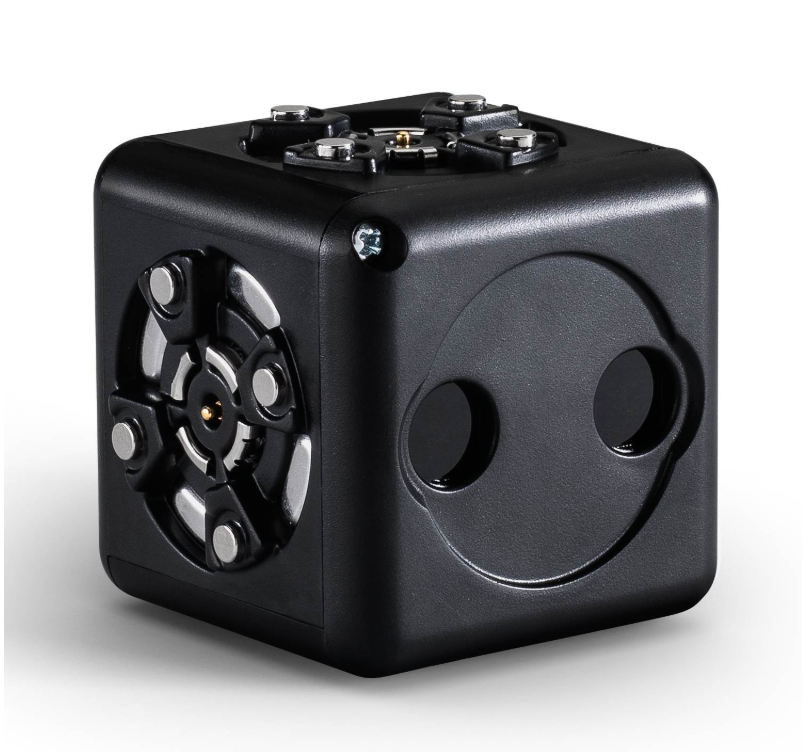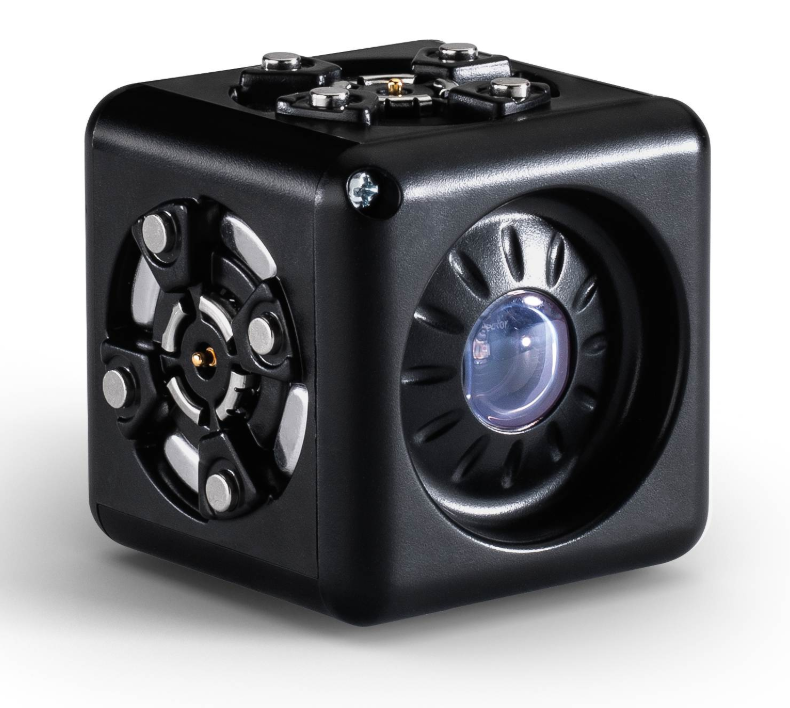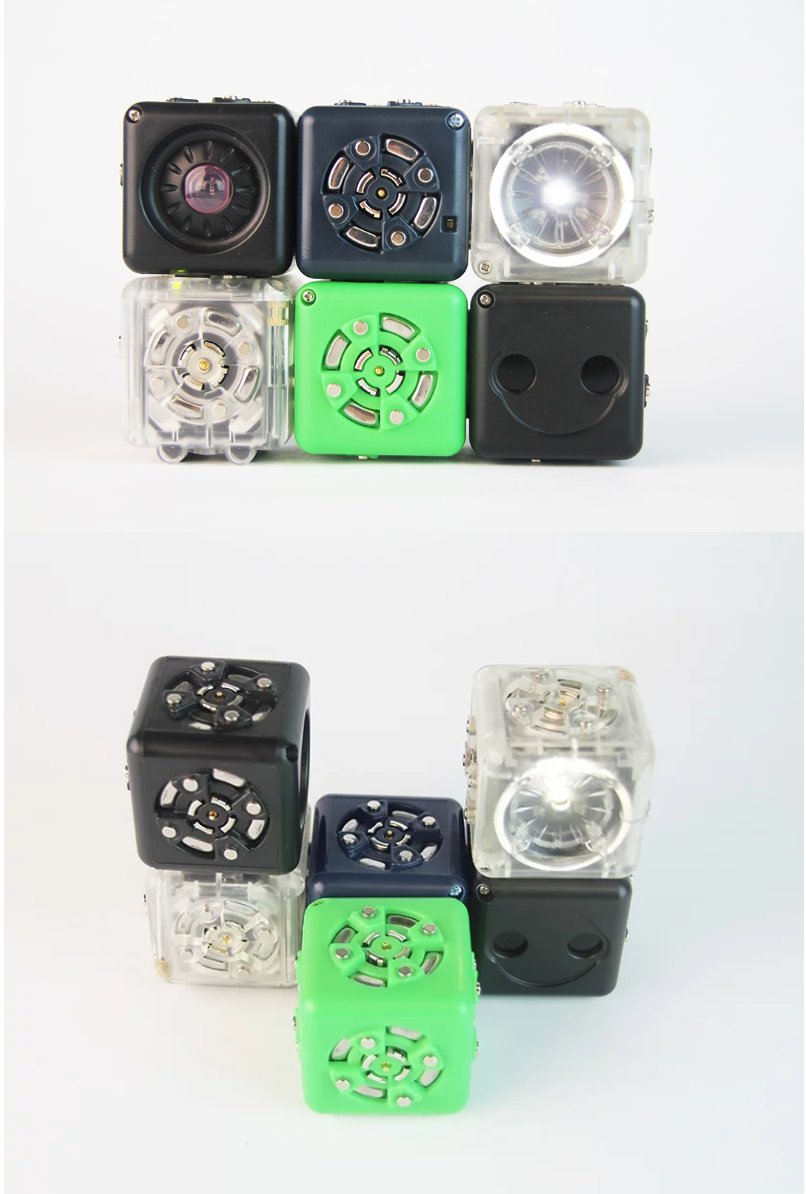Lesson Modules
Teaching Tips:
Remind each group about senses and sensory input
Tell the class: “Last class we learned about sensing, robot senses, and our senses. What did we find out about what the robot was sensing? How was that sense the same as humans sensing things? How was it different? What other senses would it be useful for robots to have? In Cubelets, all the black Cubes are sensing Cubes.
Yesterday’s black Cubelet was sensing distance. Today, let’s try a new black Cubelet and see what it is sensing."
Have the students use the Battery, Brightness, and Flashlight. and work to discover what the new sense does. (Students can be prompted to try objects other than their hands to make the light go off and on. Sometimes it is helpful to prompt them to try their robot with lights off or in a dark place.) “Now that you know what it is sensing (Brightness) can you work to make the light shine more or less. “ (Prompt students to try more or less light going into the photosensor in the Brightness Cubelet.) “What helps change the amount of response? What predicts how much light the robot will give off? “
Last class, we learned about sensing, robot senses, and our senses.
Last class's black Cubelet was sensing distance. Today, let’s try a new black Cubelet and see what it is sensing.


Use the Battery, Brightness, and Flashlight. Now let’s build a robot. You will practice following directions to build your own robot. Hold up your Battery Cube, it’s grey. Switch it on ‐ ask for help if you need it.
Now hold up the Black Cube ‐ it has a white circle in the middle. Good. Those will stick together by magnets.
Now use the Clear cube with the circle in the middle. Good work! Now let’s see what your robot does.
- Heat
- Distance
- Bright
On your own, can you try some of the same things we tried with our other robot to see if you can tell what it is sensing?

Teaching Tips:
Introduce Task
“We’ve played with a lot of Cubelets during this unit, right? And so far, how many SENSE Cubelets do we normally use when we build?”
- [one]
“Yes, so far we’ve only been building with one SENSE Cubelet. But today, we’re going to move from Cubelets Artisans to Cubelets Masters - we’re going to investigate what happens when we use two SENSE Cubelets on to construct one robot! Does anyone have any ideas about what might happen when we use both the Distance AND the Brightness Cubelets on a robot construction?
- [Students share predictions]
Review Group Norms
“First, let’s remember the Group Norms we made on the first day of this Cubelets unit.
- Review ideas on Group Norm anchor chart.
“Today, you will be in groups of [2, 3, or 4] students. Each person will have a very specific job. [Review the jobs you decided on during your preparation for class].”
- Wrap up the conversation by reviewing the group norms, separating students into their groups, and assigning group roles.
- Once students are in their groups, have them share with the other group members what their role in the group is.
“Today your group is in charge of investigating what happens when we have two SENSE Cubelets instead of only one Cubelet. After you have figured out what happens when we use two SENSE Cubelets, you are welcome to begin building robot constructions that have both two SENSE Cubelets and two ACT Cubelets. Be careful, though, using two SENSE Cubelets can make a big change to your robot! Spend some time figuring out how to explain it with your words.”
- Groups get to work investigating SENSE Cubelets one at a time.
This is an opportunity to add more excitement to their small robots while also relating robots receiving more than one set of input to themselves receiving more than one set of inputs.
Work in your group and add both Sense Cubelets.
Today your group is in charge of investigating what happens when we have two SENSE Cubelets instead of only one Cubelet. After you have figured out what happens when we use two SENSE Cubelets, you are welcome to begin building robot constructions that have both two SENSE Cubelets and two ACT Cubelets. Be careful, though, using two SENSE Cubelets can make a big change to your robot! Spend some time figuring out how to explain it with your words.

Teaching Tips:
Now that you think you know all there is to know about robots with two SENSE Cubelets, I’d like to you capture your thinking on pages. After you finish, we’ll share and revise our thinking as needed.
Teaching Tips:
“What did you discover about using two SENSE Cubelets during your investigation today?”
- [[Robot moves slower with two instead of one]
- [Can control the robot with either SENSE, but somehow they still are working together]
- [Robot averages the two SENSES: it is “halfway” between the SENSES]
- [It matters how close an ACT Cubelet is to a SENSE Cubelet]
- [SENSE Cubelets do not send commands through each other]
Notes
- It’s appropriate to say the average is in the middle of the two SENSE Cubelets. You may also include the term weighted average to include how far away the Cubelets are from each other. The further apart, the lower the “weight” of that SENSE into the average.
- Based on how your class discussion goes, you may choose to give your students time to revise their statements before submitting them to their Check for Understanding.
Intervention
If students are struggling to explain what happens when they add a second SENSE Cubelet, have them take a break by exploring with two ACT Cubelets for a few minutes. Then redirect them to choose on ACT Cubelet that is their favorite (Rotates and Flashlights are especially good for this). Have them make a 3-block robot construction with this ACT Cubelet and ask them to explain how the robot works. Then add the second SENSE Cubelet and have them explains what happens now. Is it the same? Is the light as bright? Does the rotate spin as fast? What if they shine the flashlight on and off the Brightness SENSE Cubelet?
Extension
It is unlikely students at this age will quickly grasp this concept, but for students who very quickly figure it out, ask them to use Legos and brick adapters to make their robots “come to life” with what they think it could do or be.

